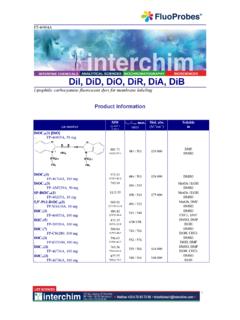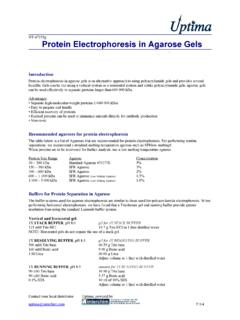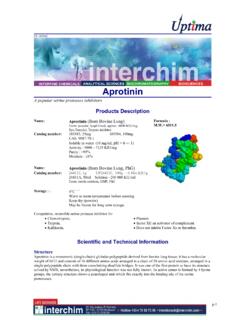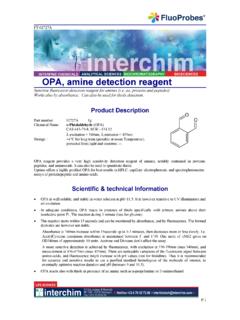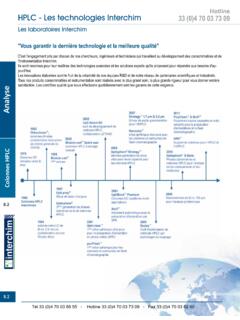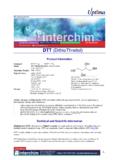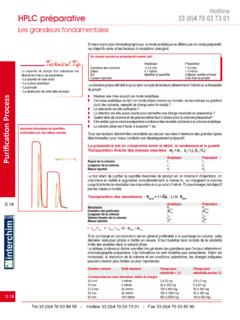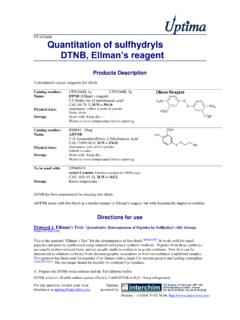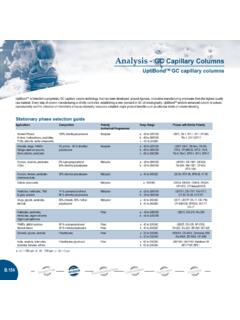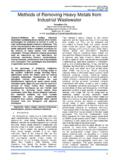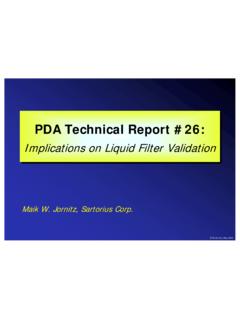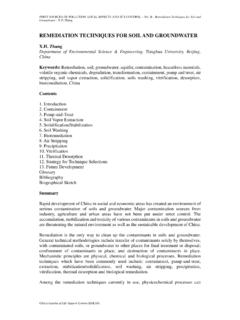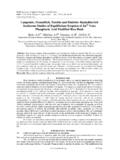Transcription of FT-062000 Good's buffers (biological buffers)
1 FT- 062000 Good's buffers ( biological buffers ) Products Description / Overview Organic biological buffers replace mineral buffers advantageously in many applications. Aminoethane and aminopropane sulfonic acids, developed and popularized by good , are now popular for biological research and analysis. good s buffers have the following characteristics: 1) High water-solubility 2) Low cell membrane permeability 3) Consistent acid-base dissociation constants 4) Low metal chelating capability 5) High chemical stability 6) Low absorption spectra in UV and visible regions. Buffering agent (by pHa value order) MW (g/mol) useful pH range pKa (20 C) pKa (25 C) pKa (37 C) MES buffer pH 14035 (h) pKa= Bis-Tris buffer pH 36832 - ADA buffer pH N1339 pKa= ACES buffer pH N1234 pKa= AH085 PIPES buffer 243(a) pH UP06198 (h) pKa= MOPSO buffer (f) pH (n) - 28148/N1420 Bis-6 Tris Propane buffer pH 24721 - BES buffer pH (n) pKa= MOPS buffer pH 06200 (n) pKa= TES buffer pH N1413 (n) pKa= HEPES buffer pH 06194 (n)
2 PKa= DIPSO buffer pH 28146 - MOBS buffer pH BP361 - - TAPSO buffer pH (n) - 28150 HEPPSO buffer (a) pH 28147 - POPSO buffer (a) pH 28149 (n) - EPPS (HEPPS) buffer (a) pH N1432 (f) - - Tricine buffer (h) 70611 pKa= Gly-Gly buffer pH 01829 - - FT- 062000 Buffering agent (by pHa value order) MW (g/mol) useful pH range pKa (20 C) pKa (25 C) pKa (37 C) Bicine buffer (f) pH T3162 pKa= HEPBS buffer (f) pH - - S5175 TAPS buffer pH pKa= 70501 AMPD buffer (f) pH 00188 - TABS buffer (f) pH 1F688 - - AMPSO buffer pH 61281 - 60653 CHES buffer pH 62519 - 62506 CAPSO buffer pH 62519 (n) - AMP buffer pH - - - CAPS buffer (f) pH 06190 pka= CABS buffer (f) pH 1F687 - (a): MW of anhydrous compound (h) hydrated compound (f) free acid compound (n) Na salt compound Please inquire for specification, and other salt forms or Storage: Room temperature (R) Introduction to buffers biological buffers allow the pH of an aqueous solution to remain constant while the concentration of hydrogen ions may change.
3 Traditional buffering systems, like carbonate and phosphate buffers , are widely used, but are often not appropriate for many biological systems. These reagents do not buffer effectively above pH , and can interfere with some biological reactions. Some of the early alternatives, such as Tris and glycylglycine, buffers are effectively at higher pH levels but often show cytotoxic effects or interfere with chemical reactions ( Tris/acylation). Dr. Norman good et al. addressed the above limitations. In 1966 he described a series of zwitterionic buffers , so-called " Good's buffers ", that are thus very useful in research in biology and biochemistry. Reference: good , , et al.
4 (1966) Hydrogen Ion buffers for biological Research. Biochemistry 5(2), 467-477 Henderson-Hasselbach Equation: buffers requirements In biological experiments, it is important to maintain the pH of the solutions used, most biological reactions occur at a neutral pH while some reactions ( peroxidase enzyme) or processes (coating on polystyrene) need acidic or alkaline pH. Mixtures of appropriate weak acids and their conjugate bases, known as buffering agents, are usually used. The buffers needs to be effective in the neutral range, typically from 6 to 8 pH, in order to be useful for cell culture in vitro, enzyme assays and some electrophoretic applications at physiological pH.
5 Furthermore, universally applicable buffers for biochemistry must be water soluble, not interfere with biological processes or biological membranes (penetration, solubilization, adsorption on surface, etc.), should not produce chelates or have known complex-forming tendency with metal ions (which are essential in biological systems), be non-toxic and have a very low absorption at wavelength >260 nm. To meet these requirements, Dr. good developed several aminoethane and aminopropane sulfonic acids that are now widely used for biological research and analysis. good s buffers have the following characteristics: FT- 062000 Good's buffers characteristics Typically, the " Good's buffers " have pKa values at or near physiological pH, are non-toxic to cells, and are not absorbed through cell membranes.
6 The concentration, temperature, and ionic composition of the medium has minimal affect on the buffering capacity. These buffers are resistant to enzymatic and non-enzymatic degradation. Furthermore, they are essentially transparent to visible and ultraviolet light, and they are relatively inexpensive. These good s buffers are widely used in cell culture and other biological applications. Since then, additional zwitterionic buffers (AMPSO, CAPSO, DIPSO, HEPPSO, MOPSO, and POPSO) have been developed. These compounds offer even further improvements in water solubility, high chemical stability, and compatibility in a number of biological systems (Ferguson et al., 1980). Characteristics of Good's buffers : pKa value between 6 and 10 high solubility non toxicity limited effect on biochemical reactions very low absorbance between 240 nm and 700 nm enzymatic and hydrolytic stability minimal changes due to temperature and concentration limited effects due to ionic or salt composition of the solution limited interaction with mineral cations, and limited permeability of biological membranes.
7 buffer choice To choose a buffering agent, the pKa value (pH at which the acid and the base forms are equimolar, hence giving a neutral total charge) should be near the pH range in which the biological reaction should be carried. Secondarily, the compatibility of the buffer with the biological system, if already documented, should be considered. Products specifications (by alphabetic order) ACES, High purity grade ACES is used to buffer at pH ( ) N-(2-Acetamido)-2-a minoethanesulfonic acid; CAS:[7365-82-4], (Z) Soluble at in water at 20 C Abs.@280nm (5%, Water) pH (1%, Water) @25C - pKa @25C - Purity (%) Water (Karl Fisher) (%) N1234A, 100g N1234B, 500g ACES K salt AH085 - Inquire ADA ADA.
8 Is useful to buffer at pH ( ). ? CAS:[26239-55-4], N-(2-Acetamido)iminodiacetic acid, N-(Carbamoylmethyl)iminodiacetic acid MW: (Z) Soluble at in 1M NaOH at 20 C Heavy Metals (ppm) < 10 Loss on Drying (%) pKa (@ 20 Deg C) - Purity (%) Residue after Ignition (%) Solubility (10%, 1N NaOH) (P/F) N1339A, 25g N1339B, 100g AMPD (2-amino-2-methyl-1,3-propanediol)) AMPD is a a useful buffer at pH , in a SDS-gradient gel electrophoresis system for polypeptide of 1500 to 100000 Da, as a spacer in isotachophoresis of proteins, and as a buffer for the determination of alkaline phosphatase activity. CAS:[115-69-5], EC:[ 204-100-7]; 2-amino-2-methyl-1,3-propanediol); (Z) Purity >99% 00188A, 25g 00188B, 100g FT- 062000 AMPSO AMPSO buffers in the pH range (pKa: at 25 C).
9 AMPSO free acid N-(1,1-Dimethyl-2-hydro xyethyl)-3-a mino-2-hydro xypropanesulfonic acid CAS:[269-991-7 ]; EC:[269-991-7 ]: MW: (Z) 61281A - Inquire AMPSO, sodium salt N-(1,1-Dimethyl-2-hydro xyethyl)-3-a mino-2-hydro xypropanesulfonic acid Na salt CAS:[102029-60-7]; EC:[]; MW: (Z) Abs.@260nm ( , Water) Abs.@280nm ( , Water) Identification (IR) (P/F): PASS Moisture (KF) : 4% Purity: 96% Solubility (10%, Water) : PASS 60653A, 25g 60653B, 100g BES BES is used to buffer at pH ( ) BES, Na salt N,N-Bis(2-hydroxyethyl)-2-a minoethanesulfonic acid sodiume sal CAS:[66992-27-6]; EC:[-]; MW: ; Xi Soluble at 1M at 20 C in water Heavy Metals (as Pb): <5ppm Loss on Drying: < Purity (anhydrous) : >99% Solubility (33%, w/v solution): PASS 61864A, 25g 61864B, 100g BES, free acid CAS:[ 10191-18-1 ]; EC:[]; MW: (Z) BA785, Inquire Bicine, high purity grade Bicine is a low temperature electrophoresis buffer ; buffer of stable substrate of serum guanase.
10 It is used to buffer at pH (Pka: ). CAS:[150-25-6], N,N-Bis(2-hydroxyethyl)glyc ine], Bis(2-hydroxyethyl)amino-tris(hydroxymet hyl) methane; (Z) Xi Soluble at 1M in water at 20 C Moisture (Karl Fischer) (%) @260nm ( , Water) @280nm ( , Water) 5 pH (1%, Water) @25C - Purity (%) Solubility (20%, Water) (P/F) T31622, 100g T31623, 1Kg BisTris, Ultrapure Bis-(2-Hydroxyethyl)a mino-tris(Hydro xy methyl)Methane CAS: [6976-37-0]; MW: (Z) GSH07 Ultrapure grade (> ; no DNase, Protease) DNase (P/F): NONE Identification (IR) (P/F): PASS Melting Point: 102 - 106 C Moisture (KF): pH ( , Water) @25C: - pKa @25C: - Protease (P/F): NONE Purity (Titration): RNase (P/F): NONE Solubility ( , Water) (P/F): PASS 36832A, 100g 36832B, 250g BisTris, Ultrapure BisTris propane 1,3-Bis[tris(hydroxy methyl)methyla mino]propane CAS:[ 64431-96-5]; EC:[264-899-3]; MW: (Z) 24721A, 25g 24721B, 100g FT- 062000 CABS CABS has a useful range of (-pHa: at 25 C) 4-(Cyclohexyla mino)-1-butanesulfonic acid CAS:[161308-34-5]; MW.
